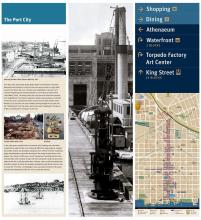Wayfinding: The Port City
The Port City

From this point, King Street slopes gently down to the Potomac. But when Alexandria was founded in 1749, the new town was perched on a high bluff some 20 feet above the river. The town was established on the shore of a crescent-shaped bay that extended inland to current-day Lee Street, then called Water Street. The steep banks that rose above the shoreline extended from Hugh West’s 1732 tobacco inspection station and warehouse, at the foot of Oronoco Street, southward to Point Lumley, near the foot of Duke Street. Between 1732 and 1749, the only roadway coming through the area was the old “Rolling Road” from the west, used to roll round “hogsheads” of tobacco to West’s warehouse for transport on the river.
In the early years, erosion from tree removal, brick making, and cultivation caused silt to wash into the river, making it difficult for large ships to navigate the shallow waters that developed along the shore. Efforts to fill the muddy bay began immediately to extend the shoreline of the newly founded town to the deeper river channel. Cliffs were cut and “banked out,” pushing land out onto the hard flats of the riverbed. Excess soil from newly built roads and structures added to the fill, as did discarded ships, ballasts, road run-off, household trash and other wastes. By 1798, the shoreline extended two full blocks into the river to create the “Port City.” Archaeologists have excavated remnants of the early wharves that extended out into the river to reach the channel.
Where to find this sign
In Old Town, mini kiosks are located at designated intersections along King Street, Cameron Street, and the Waterfront to provide an orientation for pedestrians.
This wayfinding sign is located on King at N. Lee Street. (For those taking the King Street Trolley, please check the schedule as times may have changed.)
See all the wayfinding signs on and around King Street.